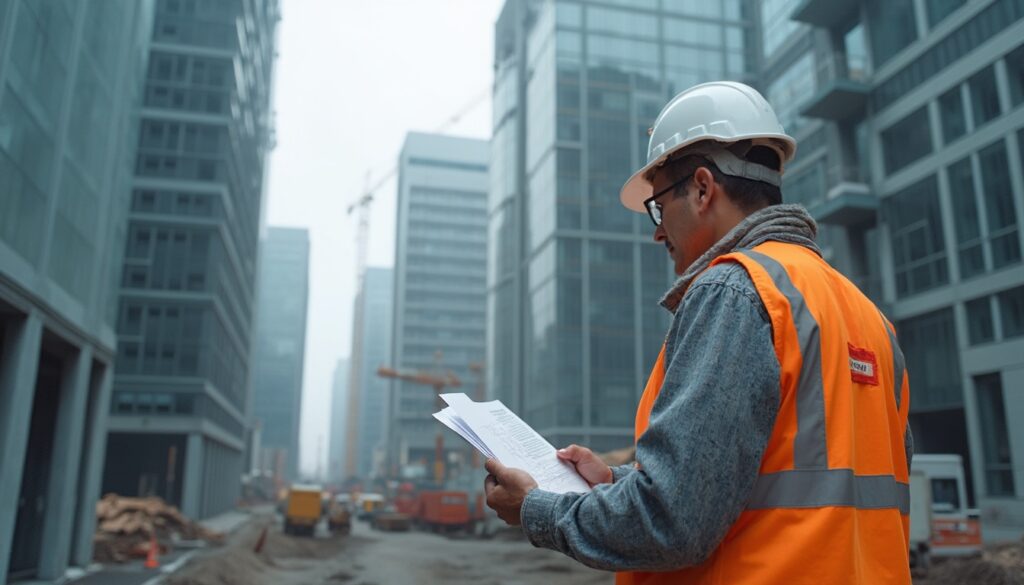The 4 Types of VOB Acceptance and Their Legal Consequences
The Procurement and Contract Regulation for Construction Services (VOB/B) regulates in § 12 the different ways in which a construction service can be accepted. Each form has specific requirements and consequences that are crucial for project managers and managing directors. Knowing these differences is the first step toward minimizing risks.
The VOB/B provides for four essential forms of acceptance that are relevant in practice:
- Formal Acceptance (§ 12 Abs. 4 VOB/B): This is the default case for VOB contracts, which can be requested by one party. It takes place at a joint meeting, and the results are recorded in a written Construction Protocol document.
- Fictive Acceptance (§ 12 Abs. 5 Nr. 1 VOB/B): If no acceptance is requested, the service is deemed accepted 12 working days after written notification of completion. This carries risks if defects remain undetected.
- Implicit Acceptance: This occurs through implicit action, for example, through the unconditional payment of the final invoice or the immediate commissioning of the construction work.
- Partial Acceptance (§ 12 Abs. 2 VOB/B): At the request of one party, self-contained parts of the service can be accepted separately, which starts the warranty period for that part sooner.
The most important consequence of acceptance is the reversal of the burden of proof. Until acceptance, the contractor must prove the absence of defects; thereafter, the client must demonstrate that a defect exists. This critical point makes comprehensive legally secure construction documentation essential. Without it, enforcing claims after acceptance becomes a significant challenge.
Minimizing Risks: Why Incomplete Documentation Becomes Expensive
The greatest risk with any acceptance under VOB is inadequate documentation. Missing photos, unclear notes, or scattered information through WhatsApp groups often do not hold up in court. This leads to substantial financial losses when clarifying defect claims.
A typical problem is the dispute over the condition at acceptance. Without a protocol recognized by both sides and clean photographic documentation, it is difficult to prove months later whether a scratch on the window was already present at the handover. The costs for such unresolved damages during the construction phase can quickly add up to 5-10% of the construction sum.
Another risk is the statute of limitations. With acceptance, the warranty period begins, typically four years for VOB/B contracts. An unclear acceptance date, as is often the case with fictive or implicit acceptances, leads to legal uncertainty. Valoon solves this problem by automatically timestamping and legally archiving every communication and document. This allows the date of completion and acceptance to be verifiably proven at any time.
Digital and Legally Secure: The Acceptance Process with Valoon
Imagine your entire acceptance process runs through a tool that your employees already use daily: WhatsApp. Valoon makes this possible and transforms informal chats into structured, legally secure construction documentation. This not only saves up to 70% of administrative effort but also eliminates typical sources of error from the analog process.
The process of formal acceptance is radically simplified:
- Send completion notifications digitally: Inform the client directly from Valoon about the completion. The completion notification according to VOB is automatically and verifiably documented.
- Digitally record defects: During the joint inspection, all defects are recorded via photos through WhatsApp. Valoon automatically assigns the images to the correct project and construction element.
- Automatically create a protocol: Instead of painstakingly typing notes, Valoon generates a complete acceptance protocol with all recorded points, photos, and comments at the push of a button.
- Legally secure archiving: The protocol and all associated evidence are stored unchangeably in the cloud and are accessible to all involved parties at any time.
This digitized process ensures that no information is lost. It creates an unambiguous foundation for further defect rectification and protects you from unjustified claims. Comprehensive documentation is your strongest argument in any dispute.
Dealing with Defects: Refusal of Acceptance and Defect Claims
Not every defect entitles the refusal of acceptance. The VOB/B distinguishes between substantial and insignificant defects. Only if a substantial defect exists, which significantly impairs usability, can the client refuse acceptance.
A substantial defect exists, for example, if the heating system does not function at sub-zero temperatures. A small scratch on a door is usually considered insignificant. The precise documentation of each defect with Valoon helps make this classification objectively and avoid unnecessary conflicts. All defects are recorded in the protocol with a deadline for rectification.
If defects are discovered only after acceptance, the client must submit a defect notice. Thanks to the reversal of the burden of proof, the client now has to prove that the defect is attributable to a faulty performance by the contractor. With the comprehensive documentation from Valoon, you can quickly check whether the defect was already present at acceptance or arose from improper use. This significantly strengthens your position when clarifying warranty claims.
The Acceptance Protocol According to VOB: Your Most Important Piece of Evidence
The acceptance protocol is the central document of acceptance under VOB. It records the condition of the work at the time of handover and is often the decisive piece of evidence in later disputes. An incomplete or unclear protocol can result in the loss of claims.
A VOB-compliant acceptance protocol must contain at least the following points:
- Information about the contracting parties and participants
- Exact designation of the construction project
- Date of the meeting
- Identified defects with exact description and location
- Deadlines for defect rectification
- Reservations due to known defects or penalties
- The explicit declaration of acceptance (or its refusal)
- Signatures of the participants
With Valoon, you create this important document not only faster but also of higher quality. Since all data is digitally recorded during the inspection, the protocol is complete and error-free. Photos are automatically assigned, improving traceability compared to a separate photo list by 100%. Thus, all revision documents according to VOB are neatly structured from the start.
Conclusion: Your Advantage with Valoon
Acceptance under VOB does not have to be a risky and time-consuming process. By digitizing with Valoon, you turn a complex legal requirement into a simple, transparent, and efficient workflow. You reduce administrative effort by up to 30% while simultaneously creating comprehensive, legally secure documentation.
The main advantages for your company are simplicity, efficiency, and legal certainty. You minimize the risk of costly legal disputes, accelerate project completion, and ensure clear conditions between all parties. All communication and documentation occur via WhatsApp – a tool that everyone on the construction site already knows and uses, without any training effort.
Secure your projects and put an end to the paper chaos. Book your free demo now and find out how Valoon can revolutionize your acceptance processes.
More Links
Administrative Regulations on the Internet provides access to official administrative regulations that may be relevant for construction services and contracts.
Der Federal Association of Experts and Consultants (BSB e.V.) informs about the construction acceptance as a crucial step in the construction process.
Das Federal Statistical Office provides official statistics and data on the construction industry in Germany.
Das Fraunhofer IESE presents a study on the digitization of the construction industry.
Der Main Association of the German Construction Industry provides current figures and facts about the construction industry in 2023.
Das Federal Institute for Construction, Urban and Spatial Research (BBSR) contains an analysis of home ownership formation among young households in Germany.
FAQ
What is an acceptance under VOB?
Acceptance under VOB is the client’s approval of the completed construction service as essentially in accordance with the contract. It is governed by § 12 VOB/B and is a crucial legal step that triggers, among other things, the due date of the final invoice, the start of the warranty period, and the transfer of risk.
Does an acceptance protocol under VOB need to be signed?
Although the VOB/B does not explicitly require a signature, it is highly recommended for the evidentiary value of the protocol. Joint signing confirms that both parties have acknowledged the contents of the protocol and agree with the findings (e.g., defect list, reservations).
What is a fictive acceptance according to § 12 Abs. 5 VOB/B?
A fictive acceptance occurs automatically without an explicit declaration of acceptance. This happens when the client does not accept the performance within 12 working days after the written notification of completion or after 6 working days following the start of use. A prerequisite is that no party has requested a formal acceptance.
Can I request a partial acceptance?
Yes, according to § 12 Abs. 2 VOB/B, the contractor can request a partial acceptance for self-contained parts of the service. This is advantageous as the warranty period for this part begins sooner, and the risk shifts to the client.
How does Valoon assist with acceptance under VOB?
Valoon digitizes the entire acceptance process via WhatsApp. You record defects with photos directly on-site, create legally secure acceptance protocols at the push of a button, and archive all documentation automatically and unchangeably. This saves time, avoids errors, and creates maximum legal certainty.
What is considered a substantial defect in VOB acceptance?
A defect is substantial if it significantly reduces the usability of the service or is safety-relevant. The decision depends on the individual case, with criteria such as the extent of the defect and the cost of rectification playing a role. Only substantial defects entitle one to refuse acceptance.








